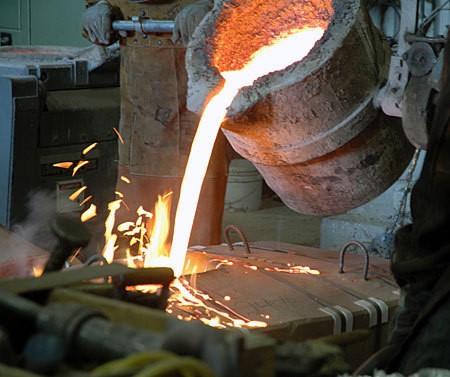

The factories that produce aluminium metal castings are commonly known as aluminium foundries. In the casting process, aluminium is melted in a liquid form, pouring into a mould and then after the aluminium cast cools off and solidifies, it is drawn from the mould or cast.

Aluminium can be cast into varying shapes and sizes, while the aluminium foundries use various types of source metal to charge the furnace, including virgin material, external scrap and internal scrap.
The aluminium foundries generally use reverberatory, gas heated crucible or electric resistance furnaces. However, periodically, hydrogen or other gases get into the casting, either by physical entrapment or chemical reaction and if this situation arises, it is removed via the de-gassing process. Aluminium castings are normally formed by die casting, but they may also be made via permanent mould casting or sand casting.
Metal casting achieved by foundries is a fundamental link in the manufacturing chain between the mines which liberate mineral resources and the manufacturers who turn them into the essential products that keep the world functioning.
The Corona crisis impact across aluminium foundries
The aluminium foundries were not spared from the global impact of Coronavirus, while the problem affecting the foundries is the widespread production ceases in the automotive industry resulted to plunge in demand for cast components. This severe strike has extremely dented the hard medium-sized and small foundries, which mainly produces component for the automotive industry like the world has witnessed the closure of MBF Aluminium Foundry in France. Now, due to the loss of orders, foundries must rethink and find creative alternatives.
The Aluminium opportunity
It has been observed that in recent years, the usage of aluminium has soared due to lightweight in automotive and the rise of e-mobility, advances in 5G technology and growing community demands for improved recyclability and widespread rejection of plastics.
The casting of aluminium comes up with several advantages. The metals lightweight property, retain strength at high temperatures and high dimensional stability for complex shapes and thin walls, good corrosion resistance, good mechanical properties and high thermal and electrical conductivity. Aluminium castings groove widespread usage in the auto industry. It needs to be emphasized that more than half of the aluminium components used in cars are produced in aluminium foundries and cast aluminium transmission housings and pistons have frequently been used in trucks and cars since the early 1900s.
The aluminium die-casting foundries are expanding by examining how different technologies and solutions can be used individually and together to optimise production at every stage to eradicate waste, improve quality and maximize efficiency through seamless integration.
Challenges incurred in the die casting process
The aluminium die-casting operations are highly resource and energy-intensive, approximately 25% of the total cost of die-cast parts is associated with energy consumption. The melt-shop alone can account for as much as 77% of the overall energy consumption in a die casting foundry.
The sustainability and the economic issue needs to be addressed due to its vital running cost for twenty-four hours. The high melting temperatures associated with metals like aluminium also impact production time and operational safety.
Aluminium’s demand changing the face of global foundries
Concerning the fulfilment of requirements of the growing global market for complex aluminium castings, aluminium-specific systems must interact graciously.
In the recent past, aluminium was the most valuable substance in the world, but now, aluminium is the most popular metal after steel, so global consumption is expected to rise to 71.14 million tonnes by 2025. Furthermore, to the automotive industry, the aerospace, mechanical engineering and packaging industries are the main drivers.
The growing restrictions on environmental legislation are enforced to reduce automotive fuel consumption and CO2 emissions. The electric vehicles must be lighter, so choosing lightweight aluminium instead of heavier steel can make a lot of sense for some components producers, particularly large structural parts makers. That’s why it has been underscored the average car will contain almost 100 extra kilos of aluminium in replacement of heavier components by 2022. However, globally, the use of aluminium in automobiles will double from around 12 % to 25 % of consumption.
Responses








